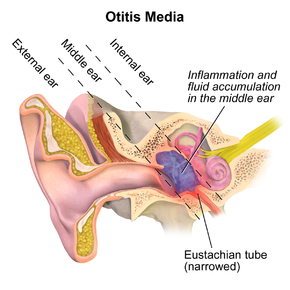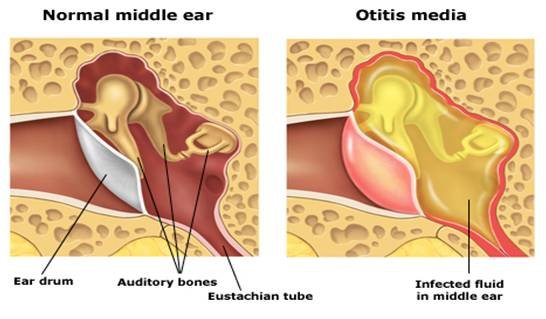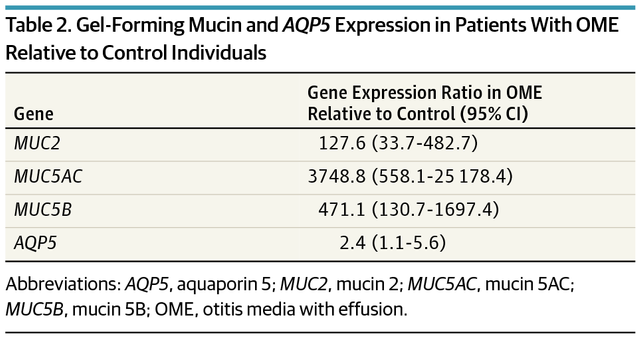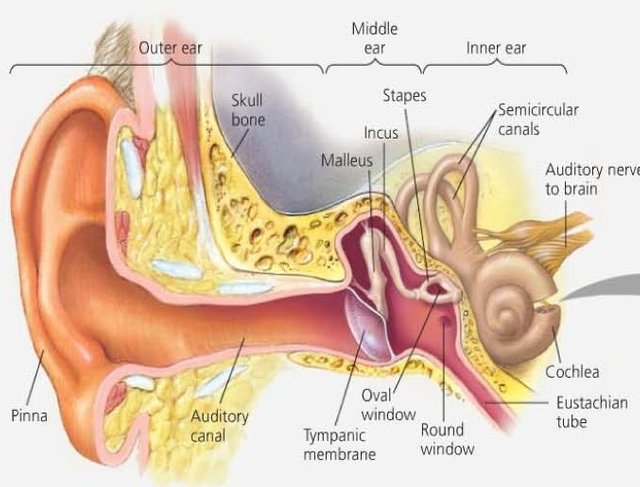Discovery of MUC5B gene in hearing loss of Otitis MEdia with Effusion Patient
Otitis media is a group of disease which is inflammatory in nature occuring in the middle ear. Generally, there are two type of Otitis Media :
- Acute Otitis media (AOM)
- Otitis media with Effusion. (OME)
The acute Otitis media (AOM) commonly abrupts in onset that usually presents with the ear pain.
Before going deep into this topic, have a look at this anatomy of the ear.
Fig: Anatomy of Ear (source)
Human ear is divided into three parts, Inner ear, Middle ear and Outer ear.Tympanic membrane (ear drum) separates the Middle ear from the Outer ear . The Eustachian tube regulates the all rounder pressure in the middle ear by closing and opening the tube.Due to this maintained pressure, there is the optimum vibration of the tympanic membrane and hearing occurs.
Generally, Otitis media happens mostly in the children but it can also happens in the adults. The main reason behind happening this Otitis Media is that the structure known as the Eustachian tube which connects the respiratory tract (Nose) and the ear is horizontal in structure compared to the adults. And during the phases of Upper Respiratory Infections in the children makes the horizontal Eustachian tube more vulnerable to infected fluid transmission in the ear from nose.

Fig: Otitis Media (source)
Etiology :
Bacterial
- Streptococcus pneumonia
- Moraxella catarrhalis
- Haemophilus Infuenza
Viral
The above mention three bacteria plays a big major role in bringing the symptoms of the otitis media.
Pathology (How does it occur ?)
When the Eustachian tube connecting the nose and the ear is blocked by some kind of allergy or infection occurring in the upper part of the Respiratory Tract . During this infection, the fluid accumulates generally in the middle ear which is behind the eardrum. Infection occurs and the middle part of the ear gets inflamed ,a condition known as Otitis Media.
There is the formation of pus in the middle ear. Build up takes place and makes a pressurized environment in the middle ear causing symptoms like
- Swelling
- Earache
- Redness
During the condition, the eardrum is forbidden for vibrating properly causing decreased hearing. Patient has a feeling of pressure or a fullness in the ear causing :
- Dizziness
- Loss of balance
- Fever
- Vomiting
- Nausea
In some of the cases, the eardrum gets enough pressurized that it gets ruptured out. Pressurized pus drains out of the ear . Commonly, the pus and the generated mucus gets remained in the Eustachian tube due to its swollen and inflamed. This condition is called as Otitis Media with Effusion. (OME)

Fig: Otitis Media with Effusion (source)
Otitis Media with effusion condition is a very serious one because it can create a hearing loss and severe ear ache. In children, the hearing loss can impair them in learning capacity and delaying in speech development. It is serious because it can also migrate the infection in the nearby structures in the head. So, recognizing the middle ear infection symptoms is very important and make sure to get a immediate attention and check up from the doctor.
If it's cured then the effective hearing can be restored to normal.
From the survey of Reuters Health of New York,
A new case control studies shows Increased expression of the mucin gene MUC5B is mainly associated with the hearing loss in the children with the Otitis media with effusion (OME) . Normal levels of MUC5B and mucin in general is much important but having this too much causes hearing loss. These gel-forming mucins are the main component of the middle ear effusion. These mucin helps in trapping and clearing the foreign particles and pathogens but its hyper-secretion can alter the mucous gel properties. Due to this, there is difficulty in effusion clearance and is airway diseases' pathologic feature including the Otitis Media.
The bacterial infection and the pro-inflamatory cytokines generally promotes the expression of the mucin 2 (MUC2), mucin 5B (MUC5B) and the mucin 5AC (MUC5AC). The water on the epithelial cell surface also additional affects the rheologic properties and the mucin hydration of the mucous gel. The aquaporins (integral membrane protein) maintain local water homeostasis. Specific aquaporins like aquaporin 5 (AQ5) alters the gel-forming mucin expression which significantly influence the viscocity of the middle ear by altering the composition of mucin.

Fig: Expression of Genes (source)
MUC5B expression is the one associated with the long term worst outcomes. This can lead to the hearing loss.
So this is all for today in this blog. Hope to see you on next blog post.
Thanks for reading !

With love
khatisam4
Source :
(1) https://www.healthline.com/health/ear-infection-acute
(2)http://www.chop.edu/conditions-diseases/otitis-media-effusion-ome
(3)https://www.ncbi.nlm.nih.gov/pubmed/20531251
